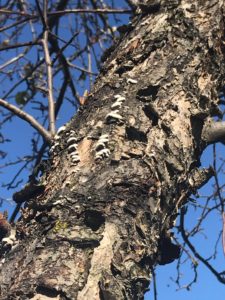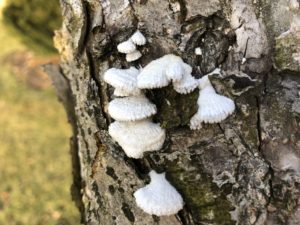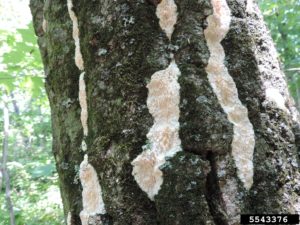Purdue’s Plant and Pest Diagnostic Lab (PPDL) receives more than 2000 samples for diagnosis each year. We’ll highlight some of the more interesting cases in the Purdue Landscape Report in brief case studies like this.
PPDL Case Study #1: White Fungi on Crabapple Branch
Earlier this year a landscaper submitted several photos of a crabapple he had been treating for apple scab and borers. He noticed white, fan-shaped fungi growing on the bark of a still-living branch (Fig. 1). At first glance this is surprising because most fungal fruiting bodies arise from dead wood. After obtaining additional photos showing the fungus close up (Fig. 2) we could identify it as Schizophyllum commune, which is reported to occur on hundreds of species of trees and is one of the most common fungi found on wood.
- Figure 1. – Crabapple trunk showing white fungal fruiting bodies of Schizophyllum commune.
- Figure 2. Close view of Schizophyllum commune on crabapple trunk showing ‘toothed’ edges of the fruiting bodies.
S. commune is a sap rot (a.k.a. canker-rot) fungus; a wound invader that spreads from an initial infection point to colonize tissue around the wound, eventually killing additional sapwood and bark. The rate of spread is linked to the extent of the wounding and overall tree vigor; as influenced by stress factors such as drought stress, defoliation from insects or disease; or root problems. In this case the crabapple was weakened by repeated defoliation due to apple scab and attack by borers. The branch will gradually die if the fungus spreads to kill the vascular tissue around the branch but it may survive for several years.
Affected wood should be removed before the fungus spreads to larger branches and the main trunk. Rapid loss of branch strength is another reason for removal of infected branches, especially on large branches that may be a hazard if they fall. While all fungal decay weakens tree branches, the sap rot fungi do so more rapidly because they attack from the outside in. This causes more decay of wood area (as viewed in cross section) and loss of strength than a heart rot fungus working in the middle of a branch or trunk.
Prevention and Treatment: Prevention depends on maintaining tree vigor and avoiding wounds. Since the fungus is inside the wood there are no effective fungicide treatments.
Might be confused with: At a distance, the fruiting bodies of Schizophyllum commune are similar to other fungi that produce numerous small, white fruiting structures on the wood surface, such as Irpex lacteus (Fig. 3) or Sarcodontia pachyodon. On closer examination, the toothed margin of the fan structure distinguishes it from other similar fungi.


